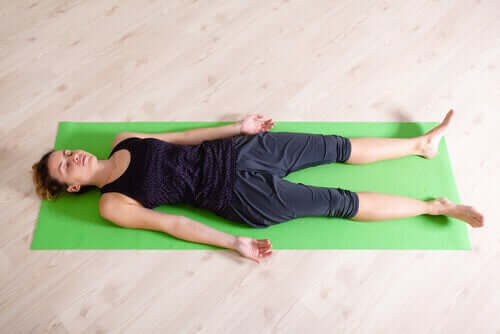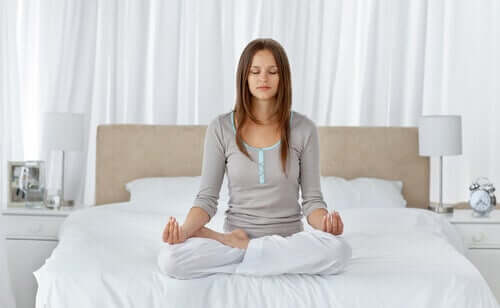How to Do Breathing Exercises to Improve Sleep

Traditionally, people count sheep to fall sleep. But we’ve got a better option: breathing exercises to improve your sleep. This way, you’ll maintain good sleep hygiene and avoid insomnia, the most common sleep disorder.
Sleep hygiene

Today’s world dynamic, which is loaded with stress and technological devices, massively increases the prevalence of anxiety and depression. This can lead to insomnia. Likewise, alcoholic intoxication or excess caffeine are harmful.
Loss of sleep greatly affects health. It decreases performance, increases tiredness, and leads to symptoms that can trigger serious conditions. Such conditions include immune system damage, endocrine damage, sexual dysfunction, irritability, loss of concentration, or memory loss.
Fortunately, it’s possible to counter these symptoms. All you need to do is learn a series of breathing exercises to improve your sleep.
Turn off your TV and phone
Before starting, it’s essential to check the conditions of your bedroom. It must be dark, tidy, and quiet. Place your alarm clock out of your field of vision, since it can increase your anxiety and obsession with falling asleep.
It’s essential to turn off your TV, cell phone, and light. This will help your body get ready to rest. Sleeping with the air conditioning on is also unhealthy.
An important recommendation is to avoid drinking fluids before bed, as waking up to go to the bathroom interrupts your sleep. Don’t take pending work or to-do lists to bed.
Waking up to sunlight resets your biological clock. If possible, sunbathe in the morning sun for an hour. This is ideal for people with sleep problems.
This article may interest you: 10 Keys to Good Sleep Hygiene
Breathing exercises to improve your sleep

Several exercises will help you counteract the stress that daily activity causes. It’s a matter of taking a few minutes to breathe, relax, and oxygenate your body and brain.
Diaphragmatic breathing
The breathing exercise specialists recommend the most is diaphragmatic or belly breathing. It improves metabolism, attention, and channels stress. Likewise, it benefits the immune system, digestion, sex, and reproduction. In addition, it strengthens the abdominal muscles.
Human beings get used to breathing with the upper part of their lungs. But taking the air to the stomach allows people to know their bodies and be more aware of the here and now. Also, it increases relaxation.
You can do the recommended exercise to boost diaphragmatic breathing by lying down or sitting upright. Place one hand on your chest and the other on your stomach, inhale through your nose and exhale through your mouth. It’s important for your stomach to inflate and your chest to remain immobile.
This type of breathing is also a great way to fight work-related stress. Three diaphragmatic or belly breaths, that relax your shoulders, neck, and forehead, will be enough to make you feel better. The brain will work in a more relaxed way and productivity will increase.
You may like this article: Discover 4 Breathing Techniques to Fight Stress
Focused breathing

Lying on your back and with your attention focused on your breathing, inhale deeply through your nose. Hold for three seconds and exhale through your mouth. Repeat the exercise eight times, resting five minutes in between.
Box or square breathing
It consists of breathing through your nose while you count to four. Hold the air for four seconds and exhale for another four seconds. Count to four again while holding your breath, and repeat eight times.
4-7-8 breathing

Separate your lips and exhale all the air. Then, close your mouth and inhale through your nose while you count to four. Hold the air until you count to seven.
Separate your lips and count to eight as you exhale through your mouth, slowly but with a hissing sound. Repeat this breathing technique four times.
Alternate nostril breathing
Firstly, cross your legs and place your left hand on your knee. Completely expel the air from your lungs and abdomen. With your right thumb, close your right nostril and inhale through your left.
Subsequently, open your right nostril and exhale through it. Maintain this rotation for five minutes and finish by exhaling through your left nostril.
To control panic attacks
The ideal exercise to counteract panic attacks consists of inhaling for six seconds and exhaling for another six seconds during one minute. Then, hold the air for 10 seconds and start the cycle again until the crisis disappears.
When you learn how to do breathing exercises to improve your sleep, your insomnia will gradually disappear. Thus, you’ll enjoy restful sleep. In turn, your well-being and quality of life will improve.
All cited sources were thoroughly reviewed by our team to ensure their quality, reliability, currency, and validity. The bibliography of this article was considered reliable and of academic or scientific accuracy.
- Eugeni García-Grau. Facultad de psicología. Barcelona. Manual de entrenamiento en respiración. Extraído de: https://www.ttmib.org/documentos/ENTRENAMIENTO_EN_RESPIRACION.pdf
- Mariano Chóliz Montañés. Facultad de Psicología. Universidad de Valencia. Relajación y respiración. Extraído de: https://www.uv.es/=choliz/RelajacionRespiracion.pdf
- Sociedad española Psiquiatría. Dormir bien. Extraído de: http://www.sepsiq.org/file/Royal/DORMIR%20BIEN.pdf
- National Health Services. Why lack of sleep is bad for your health. (2018). Recuperado el 4 de febrero de 2021. https://www.nhs.uk/live-well/sleep-and-tiredness/why-lack-of-sleep-is-bad-for-your-health/
- Harvard Medical School. Relaxation techniques: Breath control helps quell errant stress response. (2020). Recuperado el 4 de febrero de 2021. https://www.health.harvard.edu/mind-and-mood/relaxation-techniques-breath-control-helps-quell-errant-stress-response
This text is provided for informational purposes only and does not replace consultation with a professional. If in doubt, consult your specialist.








